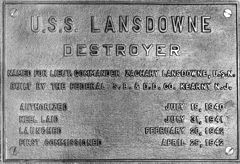Lansdowne off New York Navy Yard, 29 June 1942.
As a 1,630-ton destroyer authorized in 1940, known at the time to shipmates as a
Bristol (repeat Livermore)-class ship, the specifications for
Federal Shipbuilding & Dry Dock Co. hull no. 209,
Lansdowne reflected the characteristics of all
Gleaves-class ships built there:
Length Overall: 348' 3"
Extreme Beam: 36' 3"
Normal Displacement: 1,630 long tons
Draft: Mean: 13' 5"
Designed Complement: Officers, 11; Enlisted, 201
Designed Shaft Horsepower: 51,000
Designed Speed: 35 knots
Screws: Two
Rudder: One
Stacks: Two
At launch,
Lansdowne’s armament was typical for a mid-1942
Bristol-class destroyer, with four dual purpose 5-inch/38 cal. guns in gunhouses, a single quintuple mount between the stacks for 21-inch torpedoes, 20mm single Oerlikons (replacing five of the six 0.50 cal. machine guns of earlier ships) plus a 1.1-inch quadruple “Chicago Piano” anti-aircraft cannon aft.
Primary: 4 x 5-inch/38 cal. in four single mounts
Long-range anti-aircraft: 4 x 1.1-inch cannon in a single mount
Short-range anti-aircraft: 5 x 20mm Oerlikon in single mounts
Torpedo Tubes: 5 x 21-inch in one quintuple mount
ASW: 2 racks for 600-lb. charges; 4 “K”-guns for 300-lb. charges
Her electronics were also typical of the period just before SG (surface search) radar became available:
Radar: SC (air search) and Mk 37 (fire control)
Sonar: QC
In the spring of 1943, Lansdowne returned to San Francisco for modifications, which included installation of an SG radar set, replacement of the 1.1-inch mount and the after 20mm single with side-by-side director-controlled 40mm twin Bofors. Forward, she received a centerline 20mm mount on an elevated platform constructed forward of the bridge, plus two more—on on each side—on the after corners of the bridge wings.
Primary: 4 x 5-inch/38 cal. in five single mounts
Short-range anti-aircraft: 9 x 20mm Oerlikon in single mounts
Torpedo Tubes: 5 x 21-inch in one quintuple mount
ASW: 2 racks for 600-lb. charges; 4 “K”-guns for 300-lb. charges
In the summer of 1944, Lansdowne returned to Bremerton for another overhaul. No additional armament changes were made at this time.
Primary: 4 x 5-inch/38 cal. in five single mounts
Long-range anti-aircraft: 4 x 40mm Bofors in twin mounts
Short-range anti-aircraft: 7 x 20mm Oerlikon in single mounts
Torpedo Tubes: 5 x 21-inch in one quintuple mount
ASW: 2 racks for 600-lb. charges; 4 “K”-guns for 300-lb. charges

